 Siga nuestras sencillas instrucciones paso a paso para aprender a dibujar paisajes como esta Escena de playa tropical.
Siga nuestras sencillas instrucciones paso a paso para aprender a dibujar paisajes como esta Escena de playa tropical.
Una cascada majestuosa. Un pueblo encantador. Un tranquilo arroyo de montaña. Con la ayuda de las sencillas instrucciones de este artículo, puedes aprender a dibujar algunos de los paisajes más bellos e impresionantes de nuestro mundo. Incluso si nunca has visto algunos de estos paisajes en persona, aprender a dibujarlos será como compilar un álbum de instantáneas.
Todo lo que necesita es un lápiz No. 2, un sacapuntas, una regla y un borrador. Luego, puedes practicar dibujando una escena desértica sofocante, una cascada que cae y un camino a través de bosques cubiertos de nieve.
Cada dibujo comienza con unas pocas formas simples impresas en tinta roja. El segundo paso muestra el primer dibujo en negro. Las nuevas formas y marcas que va a agregar aparecen en rojo. Esto le muestra cómo hacer que el dibujo del paso uno se vea así en el paso dos. Los siguientes pasos también muestran los dibujos anteriores en negro y las nuevas marcas y formas en rojo.
Dibuja ligeramente con tu lápiz. Esto facilita borrar errores y otras marcas que cambian ligeramente en pasos posteriores. Cuando haya terminado, utilice un bolígrafo o un rotulador fino para oscurecer las marcas de lápiz que forman el dibujo terminado. Luego borre con cuidado las marcas de lápiz restantes.
Cuando completes todos los dibujos, tendrás 16 dibujos que muestran una amplia variedad de impresionantes paisajes.
Si lo desea, puede agregar color usando crayones o lápices de colores o marcadores. Es posible que desee recortar sus dibujos y pegarlos con cinta o pegarlos en papel de construcción de colores. Entonces podrá exhibir su colección de dibujos que muestran todo tipo de paisajes vívidos. ¡Diviértete!
Perfecciona tus habilidades de dibujo con estos paisajes:
- Campos de trigo (4 pasos)
- Cactus del desierto (4 pasos)
- Escena de playa tropical (5 pasos)
- Iglesia Campestre (5 escalones)
- Pueblo (5 pasos)
- Carril rural (5 pasos)
- Bomba de agua helada (5 pasos)
- Granero y estanque (5 pasos)
- Bote de remos en un malecón (5 escalones)
- Campo de flores (5 pasos)
- Vista de la montaña (5 escalones)
- Sendero del bosque (5 pasos)
- Arroyo de montaña (5 pasos)
- Cascada (4 escalones)
- Paisaje urbano (5 pasos)
- Escena del puerto (5 pasos)
- Cómo dibujar campos de trigo
- Cómo dibujar cactus del desierto
- Cómo dibujar una escena de playa tropical
- Cómo dibujar una iglesia rural
- Cómo dibujar un pueblo
- Cómo dibujar un camino rural
- Cómo dibujar una bomba de agua helada
- Cómo dibujar un granero y un estanque
- Cómo dibujar un bote de remos en un malecón
- Cómo dibujar un campo de flores
- Cómo dibujar una vista de montaña
- Cómo dibujar un sendero en el bosque
- Cómo dibujar un arroyo de montaña
- Cómo dibujar una cascada
- Cómo dibujar un paisaje urbano
- Cómo dibujar una escena del puerto
Cómo dibujar campos de trigo
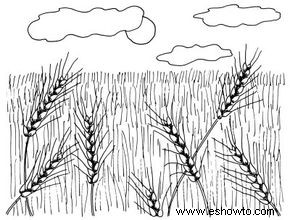
Este campo de trigo presenta un entorno natural sereno. Explorarás una variedad de formas y líneas cuando aprendas a dibujar este paisaje.
En esta sección, le mostraremos cómo dibujar este campo de trigo. Puede dibujarlo a mano alzada mientras mira el monitor de su computadora, o puede imprimir esta página para ver más de cerca cada paso.
Aquí, le mostraremos una ilustración de cada paso y luego le daremos una descripción de cómo dibujarlo. Siga las líneas rojas en cada ilustración para aprender exactamente qué dibujar en ese paso. Las líneas dibujadas en los pasos anteriores se muestran en gris.

Paso 1 :Dibuje una línea de horizonte en el centro de la página. En el área de primer plano, dibuje ligeramente óvalos largos y angostos ligeramente más angostos en la parte superior que en la parte inferior. Agregue tallos a la base de cada óvalo con pares de líneas curvas estrechas. Dibuja los tallos para que se inclinen en diferentes direcciones.
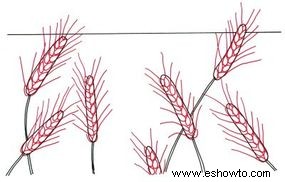
Paso 2 :Dibuja pequeños óvalos con puntas puntiagudas dentro del contorno de los tallos de trigo para los granos de trigo. Usa una combinación de líneas rectas y torcidas para dibujar una fibra larga y delgada en la punta de cada semilla.
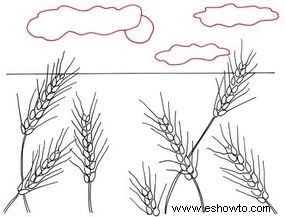
Paso 3 :Agregue el sol aproximadamente en la mitad del cielo, a mitad de camino entre las puntas de trigo más altas. Crea nubes alrededor del sol con óvalos irregulares.
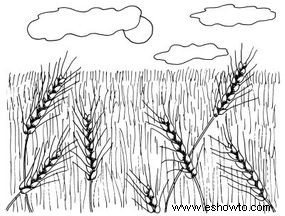
Paso 4 :Sombrea la base de cada grano de trigo con líneas muy cortas. Dibuje cuidadosamente una gran cantidad de líneas verticales ligeramente curvas para mostrar el campo de trigo en el fondo.
¡Tu dibujo de paisaje está terminado! Incluso si no lo hace bien la primera vez, siga practicando hasta que esté satisfecho con su dibujo. Casi puedes sentir el sol abrasador en la escena de los cactus del desierto en la siguiente sección. Sigue leyendo para aprender a dibujarlo en solo cuatro pasos.
¿Quieres expandir tus habilidades artísticas? Ver:
- Cómo dibujar
- Cómo dibujar personas
- Cómo dibujar dinosaurios
- Cómo dibujar flores y plantas
- Cómo dibujar caras
- Cómo dibujar caricaturas
- Cómo dibujar animales
- Cómo dibujar trenes
- Cómo dibujar barcos
- Cómo dibujar aviones
- Cómo dibujar coches
- Cómo dibujar edificios
Cómo dibujar cactus del desierto
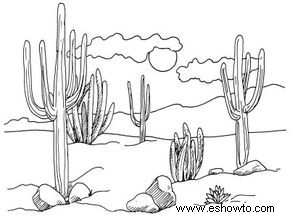 Aprende a dibujar este paisaje de cactus del desierto.
Aprende a dibujar este paisaje de cactus del desierto. Plantas de cactus, rocas, arena, sol:este paisaje de cactus del desierto lo tiene todo. Mejora tus habilidades de dibujo aprendiendo a dibujar este paisaje único.
En esta sección, le mostraremos cómo dibujar este paisaje de cactus del desierto. Puede dibujarlo a mano alzada mientras mira el monitor de su computadora, o puede imprimir esta página para ver más de cerca cada paso.
Aquí, le mostraremos una ilustración de cada paso y luego le daremos una descripción de cómo dibujarlo. Siga las líneas rojas en cada ilustración para aprender exactamente qué dibujar en ese paso. Las líneas dibujadas en los pasos anteriores se muestran en gris.
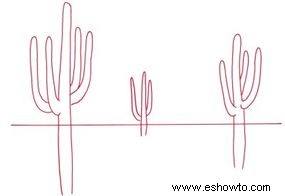
Paso 1 :dibuje ligeramente una línea en la mitad de la página para el horizonte. A la izquierda, dibuja un tronco largo en forma de lápiz para un cactus. Agregue cuatro ramas curvadas hacia arriba que sean ligeramente más estrechas. Luego dibuja dos cactus más, uno en la distancia y otro entre los cactus cercanos y lejanos.
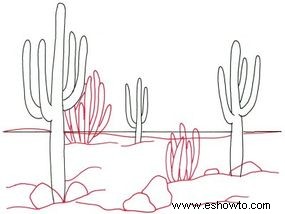
Paso 2 :Dibuja en óvalos y formas extrañas similares para rocas y cantos rodados. Usa líneas onduladas para mostrar montículos en la arena. Dibuja dos plantas de cactus más usando muchos óvalos largos y curvos. Cambia la línea recta del horizonte a una que sea ligeramente ondulada.
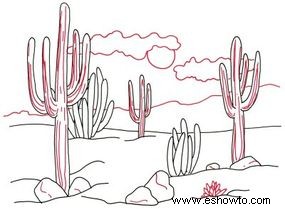
Paso 3 :Dibuja formas largas e irregulares para las nubes. Usa parte de un círculo para mostrar el sol. Sobre la línea del horizonte, dibuje una línea en ángulo y dentada para mostrar una cadena montañosa distante. Agrega líneas siguiendo la forma de los cactus para mostrar sus superficies con forma de costilla. Dibuja una planta pequeña con hojas cortas y rechonchas en el primer plano derecho. Agrega líneas curvas a las rocas para darles forma.
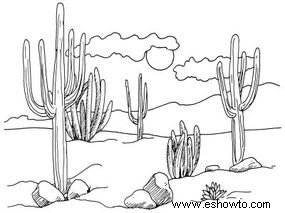
Paso 4 :Use líneas diagonales para sombrear ligeramente el fondo de las rocas. Sombrea los tallos de dos de los cactus con líneas verticales y en su mayoría diagonales.
¡Tu dibujo de paisaje está terminado! Incluso si no lo hace bien la primera vez, siga practicando hasta que esté satisfecho con su dibujo. Arena, sol y diversión te esperan en Tropical Beach Scene en nuestra próxima sección. Sigue leyendo para aprender a dibujar este paisaje en solo cinco pasos.
¿Quieres expandir tus habilidades artísticas? Ver:
- Cómo dibujar
- Cómo dibujar personas
- Cómo dibujar dinosaurios
- Cómo dibujar flores y plantas
- Cómo dibujar caras
- Cómo dibujar caricaturas
- Cómo dibujar animales
- Cómo dibujar trenes
- Cómo dibujar barcos
- Cómo dibujar aviones
- Cómo dibujar coches
- Cómo dibujar edificios
Cómo dibujar una escena de playa tropical
 Aprende a dibujar este paisaje de playa tropical.
Aprende a dibujar este paisaje de playa tropical. El sol brilla y las palmeras se mecen con la brisa en esta escena de playa tropical. Aprender a dibujar este paisaje puede ser tan relajante como estar en él.
En esta sección, le mostraremos cómo dibujar este paisaje de playa tropical. Puede dibujarlo a mano alzada mientras mira el monitor de su computadora, o puede imprimir esta página para ver más de cerca cada paso.
Aquí, le mostraremos una ilustración de cada paso y luego le daremos una descripción de cómo dibujarlo. Siga las líneas rojas en cada ilustración para aprender exactamente qué dibujar en ese paso. Las líneas dibujadas en los pasos anteriores se muestran en gris.

Paso 1 :coloque una línea de horizonte clara aproximadamente en la mitad de la página. Dibuja el casco de un velero con un rectángulo largo que tenga un extremo o proa hacia arriba y puntiagudo. Haz la vela usando un triángulo con dos lados curvos y un fondo plano. Dibuja una segunda línea ligeramente curva debajo del bote para representar la costa.
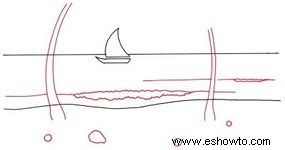
Paso 2 :Da forma a los troncos de las palmeras con dos conjuntos de líneas curvas que se estrechan a medida que suben. Dibuja algunas formas redondeadas en la playa de arena para cocos y rocas. Muestra las olas cerca de la costa con pares de líneas onduladas. Extiende cada ola con líneas simples.
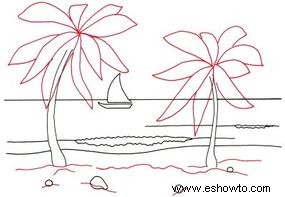
Paso 3 :Dibuje el contorno básico de las hojas grandes en la parte superior de las palmeras. Agrega líneas irregulares cerca de los árboles y las rocas para dar contorno a la playa.

Paso 4 :Dé forma a las hojas de palma con líneas largas y dentadas, como se muestra. Usa un par de líneas curvas para hacer rayas en la vela del barco. Dibuja algunas olas más en la superficie del mar. Ponga en líneas cortas en la superficie frontal de la primera ola. Añade líneas muy cortas a los cocos.

Paso 5 :Use una serie de líneas diagonales paralelas para sombrear un lado de los troncos de los árboles, el velero y la roca. Complete el dibujo con puntos y garabatos para mostrar la espuma de una ola rompiendo. Añade varias líneas a la superficie del agua.
¡Tu dibujo de paisaje está terminado! Incluso si no lo hace bien la primera vez, siga practicando hasta que esté satisfecho con su dibujo. Un camino de piedra conduce a una encantadora iglesia rural en la siguiente sección. Sigue leyendo para aprender a dibujar esta escena en solo cinco pasos.
¿Quieres expandir tus habilidades artísticas? Ver:
- Cómo dibujar
- Cómo dibujar personas
- Cómo dibujar dinosaurios
- Cómo dibujar flores y plantas
- Cómo dibujar caras
- Cómo dibujar caricaturas
- Cómo dibujar animales
- Cómo dibujar trenes
- Cómo dibujar barcos
- Cómo dibujar aviones
- Cómo dibujar coches
- Cómo dibujar edificios
Cómo dibujar una iglesia rural
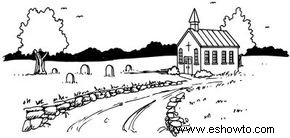 Aprende a dibujar este paisaje de iglesia rural.
Aprende a dibujar este paisaje de iglesia rural. Esta iglesia rural se encuentra al final de un camino de piedra rodeado de frondosos árboles. Te lo pasarás en grande aprendiendo a dibujar todos los componentes de este encantador paisaje.
En esta sección, le mostraremos cómo dibujar este paisaje de iglesia campestre. Puede dibujarlo a mano alzada mientras mira el monitor de su computadora, o puede imprimir esta página para ver más de cerca cada paso.
Aquí, le mostraremos una ilustración de cada paso y luego le daremos una descripción de cómo dibujarlo. Siga las líneas rojas en cada ilustración para aprender exactamente qué dibujar en ese paso. Las líneas dibujadas en los pasos anteriores se muestran en gris.
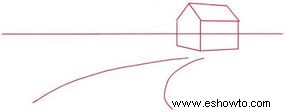
Paso 1 :Dibuje una línea horizontal clara para el horizonte. Colóquelo aproximadamente en el medio de su área de dibujo. Haz un rectángulo cerrado para el lado largo del edificio de la iglesia. Agregue un rectángulo de tres lados que esté abierto en la parte superior para el frente. Haz que todas las líneas verticales sean paralelas.
Use un rectángulo inclinado para el lado visible del techo. Conecte la parte superior del techo a la parte superior de la línea inclinada de la izquierda para completar el contorno. Indique el comienzo de un camino con dos líneas curvas que se juntan cerca del costado del edificio de la iglesia.
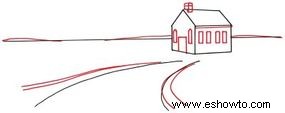
Paso 2 :agregue algunas curvas suaves a la línea del horizonte. Comienza las ventanas, la puerta y el campanario de la iglesia con rectángulos. Use rectángulos con semicírculos en la parte superior para las ventanas delanteras. Agregue un segundo conjunto de líneas a lo largo de la calzada como el comienzo de un muro de piedra.

Paso 3 :Coloque un par de árboles en el paisaje para darle profundidad. Use un tronco grueso que cambie a dos grandes ramas principales para el primer árbol. Cubra ambos árboles con un óvalo de hojas, hecho con líneas onduladas. Agregue cinco o seis formas de U invertidas como lápidas. Dale profundidad a cada uno de ellos añadiendo una línea curva en el lado derecho.
Comience a agregar detalles a la iglesia. Termina el campanario con dos formas en V invertidas una al lado de la otra. Espacie uniformemente seis líneas en el techo, paralelas a las líneas que ya están allí. Use líneas onduladas en forma de óvalos aplanados para los arbustos en el frente. Pon líneas horizontales cortas debajo de cada ventana y una línea vertical en el centro de la entrada.
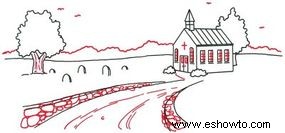
Paso 4 :Delinee piedras individuales en las paredes a lo largo del camino con óvalos irregulares de diferentes tamaños. Use principalmente líneas verticales en los lados de los árboles para darles la apariencia de corteza. Agregue una línea de árboles en la distancia para brindar profundidad.
Dibuja algunos pájaros en el cielo con pares de líneas cortas y redondeadas. Coloque una serie de líneas largas y curvas para crear baches en el camino. Complete la iglesia con pequeños rectángulos en la puerta, líneas verticales cortas para las manijas y líneas de intersección rectas para las ventanas. Haz una cruz encima de la puerta.
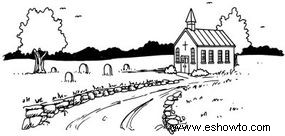
Paso 5 :Utilice sombras oscuras para los árboles del fondo. Crea una sombra al costado de la iglesia con una serie de líneas horizontales torcidas. Agregue matas de hierba alrededor de las lápidas y el árbol con líneas cortas y rectas, espaciadas muy juntas.
Esparce formas puntiagudas y dentadas como matas de hierba a los lados de la carretera y en puntos aleatorios de los campos circundantes. Forme marcos debajo de cada ventana agregando líneas verticales cortas para terminar los rectángulos largos que son un poco más anchos que las ventanas mismas. Con líneas diagonales, sombree ligeramente parte de la superficie de las piedras en la pared.
¡Tu dibujo de paisaje está terminado! Incluso si no lo hace bien la primera vez, siga practicando hasta que esté satisfecho con su dibujo. La escena del pueblo en la siguiente sección lo incluye todo:una pequeña iglesia, una casa e incluso un granero. Sigue leyendo para aprender a dibujar este paisaje en solo cinco pasos.
¿Quieres expandir tus habilidades artísticas? Ver:
- Cómo dibujar
- Cómo dibujar personas
- Cómo dibujar dinosaurios
- Cómo dibujar flores y plantas
- Cómo dibujar caras
- Cómo dibujar caricaturas
- Cómo dibujar animales
- Cómo dibujar trenes
- Cómo dibujar barcos
- Cómo dibujar aviones
- Cómo dibujar coches
- Cómo dibujar edificios
Cómo dibujar un pueblo
 Aprende a dibujar este paisaje de pueblo.
Aprende a dibujar este paisaje de pueblo. Esta encantadora escena de pueblo lo tiene todo:una iglesia, una casa y un granero con el telón de fondo de una puesta de sol. Lo mejor de todo es que es fácil de dibujar con la ayuda de nuestras sencillas instrucciones.
En esta sección, le mostraremos cómo dibujar este paisaje de pueblo. Puede dibujarlo a mano alzada mientras mira el monitor de su computadora, o puede imprimir esta página para ver más de cerca cada paso.
Aquí, le mostraremos una ilustración de cada paso y luego le daremos una descripción de cómo dibujarlo. Siga las líneas rojas en cada ilustración para aprender exactamente qué dibujar en ese paso. Las líneas dibujadas en los pasos anteriores se muestran en gris.

Paso 1 :dibuje una línea horizontal ligeramente por debajo de la mitad de la página. Dibuja la primera línea de árboles justo encima de la línea horizontal, usando una línea ondulada continua. Para cada edificio, usa una regla para hacer tres líneas rectas verticales paralelas entre sí.
Para los dos edificios de la izquierda, conecta dos de las líneas con forma de V invertida. Luego dibuja el techo como un rectángulo inclinado. Para el granero de la derecha, conecte dos de las líneas verticales con dos líneas en ángulo como se muestra. Usa dos rectángulos inclinados para el techo.

Paso 2 :Continúe agregando ventanas y puertas a los edificios con pequeños cuadrados y rectángulos. Las líneas verticales deben ser paralelas. Comience a dibujar un campanario de iglesia para el edificio de la izquierda con forma de caja de dos lados. Agregue un pequeño cuadrado a la casa del medio para una chimenea. Dibuja una segunda línea cerca de la línea del techo del granero para darle profundidad.

Paso 3 :agregue una segunda línea de árbol encima de la primera para mostrar los árboles en el fondo. Termina la parte superior del campanario con dos formas triangulares y coloca una cruz directamente sobre la puerta. Dibuja dos formas irregulares y redondeadas para los árboles. Usa líneas ligeramente curvas para los troncos. Coloque parte de un círculo para el sol cerca del horizonte. Dibuja líneas largas y ligeramente irregulares para mostrar nubes tenues.

Paso 4 :Para la iglesia, dale textura al techo con líneas diagonales. Usa líneas horizontales para el techo de la casa. Para el techo del granero, use líneas en ángulo que sigan la forma del techo. Muestre paneles en las ventanas con cruces, como se muestra. Dibuja un rectángulo en la puerta de la casa y la iglesia. Agregue un picaporte a cada uno con un punto. Use una combinación de líneas horizontales y verticales en forma de V para las tablas en la puerta del granero.

Paso 5 :oscurece la línea superior del árbol en el fondo para separarla de la inferior en primer plano. Coloque una serie de diminutas formas redondas y ovaladas al azar en las paredes de la iglesia para obtener un efecto de piedra. Crea la apariencia de un revestimiento de madera en el granero con una serie de líneas verticales.
¡Tu dibujo de paisaje está terminado! Incluso si no lo hace bien la primera vez, siga practicando hasta que esté satisfecho con su dibujo. En la siguiente sección, un dosel de árboles cubre un tranquilo camino rural. Sigue leyendo para aprender a dibujar este paisaje en solo cinco pasos.
¿Quieres expandir tus habilidades artísticas? Ver:
- Cómo dibujar
- Cómo dibujar personas
- Cómo dibujar dinosaurios
- Cómo dibujar flores y plantas
- Cómo dibujar caras
- Cómo dibujar caricaturas
- Cómo dibujar animales
- Cómo dibujar trenes
- Cómo dibujar barcos
- Cómo dibujar aviones
- Cómo dibujar coches
- Cómo dibujar edificios
Cómo dibujar un camino rural
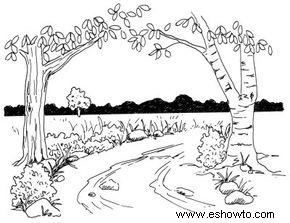 Aprende a dibujar este paisaje de calle rural.
Aprende a dibujar este paisaje de calle rural. Con una silueta de bosque en el fondo y un dosel de árboles en primer plano, este camino rural es una escena de naturaleza pacífica. Este paisaje es un maravilloso desafío de dibujo para los amantes de la naturaleza.
En esta sección, le mostraremos cómo dibujar este paisaje de camino rural. Puede dibujarlo a mano alzada mientras mira el monitor de su computadora, o puede imprimir esta página para ver más de cerca cada paso.
Aquí, le mostraremos una ilustración de cada paso y luego le daremos una descripción de cómo dibujarlo. Siga las líneas rojas en cada ilustración para aprender exactamente qué dibujar en ese paso. Las líneas dibujadas en los pasos anteriores se muestran en gris.
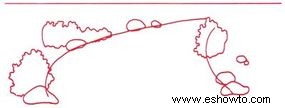
Paso 1 :dibuje ligeramente una línea de horizonte justo encima del centro de la página. Áspero en dos líneas largas y curvas que se unen un poco para el contorno de la carretera. Dibuja algunos óvalos grandes para las rocas, colocándolos al azar a lo largo de los lados del camino. Haz tres arbustos con líneas onduladas para definir el camino y distinguirlo de los campos circundantes.
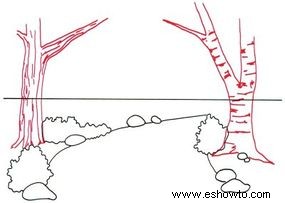
Paso 2 :Dibuja un árbol y ramas a la izquierda, con un tronco principal alto. Muestre la corteza en el costado del tronco con largas líneas hacia arriba y hacia abajo. Usa líneas horizontales cortas para el árbol de la derecha, un abedul, que tiene un tronco principal más pequeño. Al rellenar líneas en el abedul, observe que las líneas son aproximadamente horizontales, no verticales como el otro árbol.
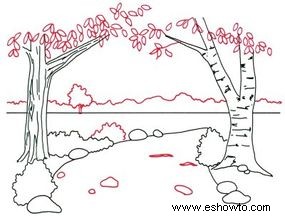
Paso 3 :Dibuje una línea ondulada a lo largo de la página, justo encima de la línea del horizonte, para indicar las copas de los árboles distantes. Agregue ramas más pequeñas a los árboles con algunas líneas torcidas. Organice docenas de hojas en grupos aleatorios dibujando formas como lágrimas. Coloque un árbol más en el fondo y otro arbusto junto a la carretera con líneas circulares onduladas. Dibuja varias formas oblongas irregulares en el camino para que parezcan rocas y piedras.
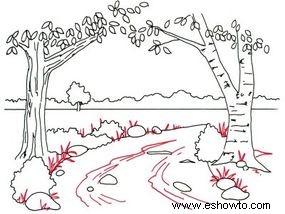
Paso 4 :Haga una serie de líneas más o menos paralelas para que parezcan surcos en la superficie de la calzada. Dibuja varios grupos de hierba alta al borde del camino y alrededor de los arbustos. Dales forma de púas:la mayoría en posición vertical, pero algunas están dobladas.
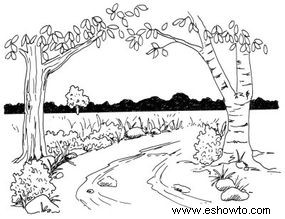
Paso 5 :Sombree mucho el área entre el horizonte y la parte superior de la línea de árboles. Agregue líneas cortas y onduladas al árbol distante. Use el mismo método para los arbustos a lo largo del camino. Dibuja algunas líneas muy cortas para que parezcan mechones de hierba en el campo. Como último paso, sombrea ligeramente las rocas.
¡Tu dibujo de paisaje está terminado! Incluso si no lo hace bien la primera vez, siga practicando hasta que esté satisfecho con su dibujo. Una bomba de agua se ha congelado en la nieve en la siguiente escena. Sigue leyendo para aprender a dibujar este paisaje en solo cinco pasos.
¿Quieres expandir tus habilidades artísticas? Ver:
- Cómo dibujar
- Cómo dibujar personas
- Cómo dibujar dinosaurios
- Cómo dibujar flores y plantas
- Cómo dibujar caras
- Cómo dibujar caricaturas
- Cómo dibujar animales
- Cómo dibujar trenes
- Cómo dibujar barcos
- Cómo dibujar aviones
- Cómo dibujar coches
- Cómo dibujar edificios
Cómo dibujar una bomba de agua helada
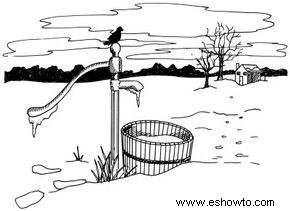 Aprende a dibujar este paisaje de bomba de agua helada.
Aprende a dibujar este paisaje de bomba de agua helada. Una bomba de agua rural se ha helado en el frío invernal de este paisaje. Preste mucha atención a la perspectiva cuando trabaje en este dibujo.
En esta sección, le mostraremos cómo dibujar este paisaje de bomba de agua helada. Puede dibujarlo a mano alzada mientras mira el monitor de su computadora, o puede imprimir esta página para ver más de cerca cada paso.
Aquí, le mostraremos una ilustración de cada paso y luego le daremos una descripción de cómo dibujarlo. Siga las líneas rojas en cada ilustración para aprender exactamente qué dibujar en ese paso. Las líneas dibujadas en los pasos anteriores se muestran en gris.
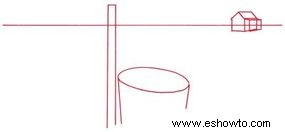
Paso 1 :croquice una línea de horizonte como punto de partida. En el lado derecho de la línea, use una figura de cinco lados para la pared frontal de una casa. Extienda líneas paralelas hacia atrás desde tres puntos de la figura para formar el costado y el techo. Adjunte una forma de caja más pequeña a un lado. En primer plano, delinee una forma angosta similar a un poste, usando líneas paralelas. Esto forma el comienzo de la bomba de agua. Haz la parte superior de un barril de madera con un óvalo grande. Cuelga líneas rectas desde los extremos del óvalo.
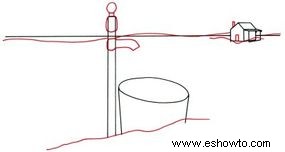
Paso 2: Para un montículo de nieve, extienda una línea ondulada a lo largo del primer plano debajo de la bomba y el barril. Cambie el horizonte en el fondo de una línea recta a una ligeramente curva. Dibuja un pequeño círculo sobre un rectángulo redondeado para la parte superior de la bomba. Forme un grifo con un rectángulo largo con un giro en un extremo. Usa pequeños rectángulos para formar la puerta y la chimenea de la casa.
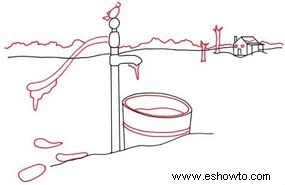
Paso 3 :Haga huellas en la nieve con algunas formas oblongas a la izquierda de la bomba. Dale grosor al barril dibujando un segundo óvalo justo dentro del primero. Dibuja una línea doble curva para una banda alrededor del barril. Use una línea curva para la nieve dentro del contenedor. Forme el mango de la bomba con líneas suavemente curvas y un extremo redondeado. Usa líneas irregulares para formar un montón de hielo.
Agregue un carámbano con una forma puntiaguda alargada en la punta del grifo, más dentado que en el mango. En el fondo, haz una línea larga y ondulada para dar la apariencia de una cadena montañosa. Dibuja los troncos de dos árboles con copas dentadas cerca de la casa. Agregue una línea curva al techo para dar la apariencia de nieve. Coloque dos ventanas en la casa dibujando pequeños cuadrados. Agrega una combinación de óvalos y triángulos para formar la forma rugosa de un pájaro en el mango de la bomba.
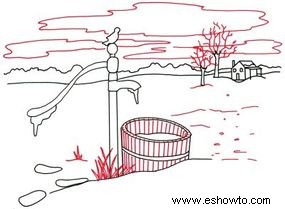
Paso 4 :Agregue con cuidado muchas líneas paralelas estrechamente espaciadas para que parezcan listones en el barril. Dibuja un poco de hierba alta y larguirucha con tallos puntiagudos que se superponen entre sí. Rellene el espacio entre el barril y la casa con algunas líneas cortas, pequeños óvalos y otras formas extrañas. Complete las ramas en la parte superior de los dos árboles con una mezcla de líneas rectas y dentadas. Dibuja nubes de invierno largas y delgadas, con líneas curvas suaves y pronunciadas, para llenar el cielo.
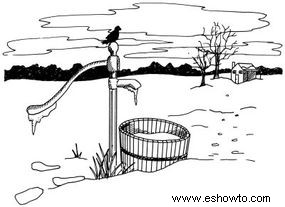
Paso 5 :Termine el paisaje con un cuidadoso sombreado. El sombreado más oscuro oscurece el ave y el espacio entre la línea del horizonte y las cimas de las montañas. Agregue una cruz a cada una de las ventanas para los cristales de las ventanas. Dibuja un punto en la puerta para el picaporte. Use líneas diagonales para obtener un sombreado más claro en los troncos de los árboles, el costado de la casa, dentro del barril de agua y en la bomba misma.
¡Tu dibujo de paisaje está terminado! Incluso si no lo hace bien la primera vez, siga practicando hasta que esté satisfecho con su dibujo. El encantador paisaje de granero y estanque incluye un estanque tranquilo, un granero rústico e incluso un pato flotante. Aprende a dibujar este paisaje en la siguiente sección.
¿Quieres expandir tus habilidades artísticas? Ver:
- Cómo dibujar
- Cómo dibujar personas
- Cómo dibujar dinosaurios
- Cómo dibujar flores y plantas
- Cómo dibujar caras
- Cómo dibujar caricaturas
- Cómo dibujar animales
- Cómo dibujar trenes
- Cómo dibujar barcos
- Cómo dibujar aviones
- Cómo dibujar coches
- Cómo dibujar edificios
Cómo dibujar un granero y un estanque
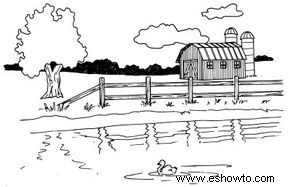 Aprende a dibujar este paisaje de granero y estanque.
Aprende a dibujar este paisaje de granero y estanque. Esta escena de la vida en la granja incluso incluye un pato adorable, flotando felizmente sobre un estanque. Esta escena de paisaje tiene una buena variedad de elementos para dibujar:agua, edificios, plantas y animales.
En esta sección, le mostraremos cómo dibujar este paisaje de granero y estanque. Puede dibujarlo a mano alzada mientras mira el monitor de su computadora, o puede imprimir esta página para ver más de cerca cada paso.
Aquí, le mostraremos una ilustración de cada paso y luego le daremos una descripción de cómo dibujarlo. Siga las líneas rojas en cada ilustración para aprender exactamente qué dibujar en ese paso. Las líneas dibujadas en los pasos anteriores se muestran en gris.

Paso 1 :dibuje ligeramente una línea de horizonte en el medio de la página. Comience el contorno del granero con un rectángulo para el lado largo, luego agregue el frente como un rectángulo abierto en la parte superior. Todas las líneas verticales deben ser paralelas. Conecte dos de las líneas verticales con dos líneas en ángulo, como se muestra.
Usa rectángulos inclinados para el techo. Comience el borde del lago con una línea casi recta para mostrar el borde del agua. Dibuja otra línea irregular encima para mostrar el límite del área de arena.
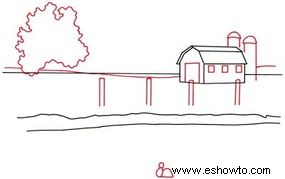
Paso 2 :Modifique la línea del horizonte para que baje frente al granero y se eleve detrás de él. Comience a definir el granero colocando rectángulos para las ventanas y una puerta grande. Enmarca torres gemelas de silo con rectángulos altos y cúbrelas con semicírculos.
Comience un árbol a la izquierda dibujando en la parte superior frondosa con una línea ondulada. Dibuja postes de cerca con rectángulos estrechos y abiertos. Alinea la parte superior de los postes con una regla. Combina un círculo pequeño con un óvalo y medio círculo para hacer el contorno de un pato en el estanque.
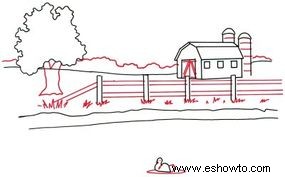
Paso 3 :Agregue un punto para el ojo del pato, una pequeña figura en forma de V para un pico y una cola esponjosa para que el pato se vea más real. Forma un óvalo delgado a su alrededor para formar una onda circular. Attach the rails between the posts by drawing horizontal and diagonal lines with the help of a ruler. Use a combination of V-shaped and horizontal and vertical lines for boards on the barn door.
Show sections in the silo with curved lines. Sketch the tree trunk using wavy lines. Use a squiggly line to form the top of the tree line in the background. Add tufts of grass along the edge of the pond with a series of jagged lines.
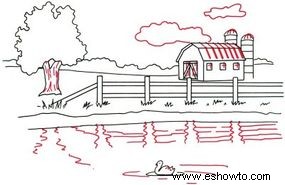
Step 4 :Add clouds in the sky above the barn with irregular shapes. Give texture to the barn door with vertical lines. For the barn roof, use angled lines that follow the shape of the roof. Put crosses in the windows for windowpanes. Finish the top of the silo with four curved lines. Give texture to the tree trunk with broken lines. Show the reflections of the tree and fence on the water with wavy lines. Add a few feathers to the duck with tiny hooked lines.
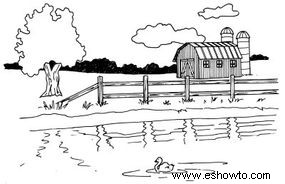
Step 5 :Darken the tree line in the background. Give the barn the look of wood siding with many closely spaced, parallel lines. Shade under the barn roof with crisscross lines. Finish with light shading to give texture to the fence.
Your landscape drawing is finished! Even if you don't get it right the first time, keep practicing until you're happy with your drawing. A rowboat waits patiently at a seawall for a ride on the lake. Learn how to draw this landscape in the next section.
Want to expand your artistic abilities? See:
- How to Draw
- How to Draw People
- How to Draw Dinosaurs
- How to Draw Flowers and Plants
- How to Draw Faces
- How to Draw Cartoons
- How to Draw Animals
- How to Draw Trains
- How to Draw Boats
- How to Draw Planes
- How to Draw Cars
- How to Draw Buildings
How to Draw a Rowboat at a Seawall
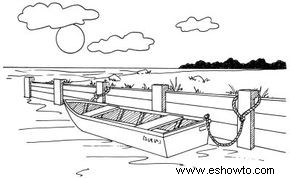 Learn how to draw this rowboat at a seawall landscape.
Learn how to draw this rowboat at a seawall landscape. In this landscape scene, the sun shines on a rowboat tied to a seawall. This is a great landscape drawing for people who love the water and the shore.
In this section, we'll show you how to draw this rowboat at a seawall landscape. You can draw it freehand while looking at your computer monitor, or you can print out this page to get a closer look at each step.
Here, we'll show you an illustration of each step and then give you a description of how to draw it. Follow the red lines in each illustration to learn exactly what to draw in that step. The lines drawn in previous steps are shown in gray.
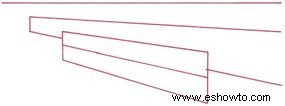
Step 1 :Sketch a straight line to represent the horizon. Use your ruler to outline a long rectangle that widens and is open at the right end. To show the position of the rowboat, make a second, closed rectangle that overlaps the first. Draw a line through its center.
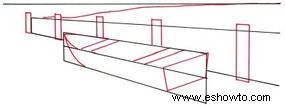
Step 2 :Sketch an irregular line that meets the horizon on the right for the shoreline. With a ruler, place five tall, narrow rectangles next to the longer, horizontal rectangle, as shown. Make sure the tops and bottoms are in a straight line (check with a ruler).
Continue the rowboat by forming the bow or front end with three curved lines. Then arrange two seats with sets of parallel lines. Use a ruler to help get the lines to match. Draw another line parallel to the seats for the stern or rear end of the boat. Extend lines down from the ends of the last line and connect them to make another four-sided figure.
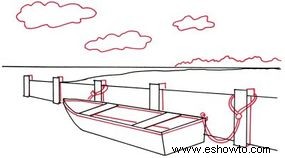
Step 3 :Make an irregular, jagged line in the background, above the horizon line, to represent a mountain range. Add depth to the posts by using slanted rectangles at the sides and L-shaped lines at the top. Arrange two sets of curving, closely parallel lines for ropes to tie up the boat at both ends. Draw a few straight and curving lines to show the inside of the rowboat. Sketch a few irregular shapes for clouds in the sky.
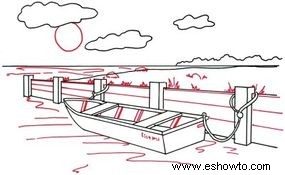
Step 4 :Place a circular sun in the lower part of the sky. Suggest the surface of the water with curvy lines placed at random, both near the boat and in the distance. Put sets of diagonal lines inside the boat to show its riblike structure. Fill in a name of your choice on the side or back surface. Form the sea wall with parallel horizontal lines between the posts. Make a bunch of jagged or spiky shapes for tufts of grass, then add a few large ovals as rocks.
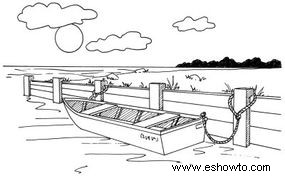
Step 5 :Use heavy shading for the distant tree line. Shade the sides of the posts and the inside of the boat with diagonal lines. Finish the ropes with a series of very short curved lines.
Your landscape drawing is finished! Even if you don't get it right the first time, keep practicing until you're happy with your drawing. A field of flowers bloom under the sun in a lovely vision of spring. Learn how to draw this landscape in the next section.
Want to expand your artistic abilities? See:
- How to Draw
- How to Draw People
- How to Draw Dinosaurs
- How to Draw Flowers and Plants
- How to Draw Faces
- How to Draw Cartoons
- How to Draw Animals
- How to Draw Trains
- How to Draw Boats
- How to Draw Planes
- How to Draw Cars
- How to Draw Buildings
How to Draw a Field of Flowers
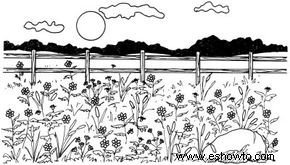 Learn how to draw this field of flowers landscape.
Learn how to draw this field of flowers landscape. Several elements of nature combine to create this lovely landscape scene -- sun and clouds, trees, stone, and a field of flowers. This landscape will give you a great chance to practice drawing a variety of flowers.
In this section, we'll show you how to draw this field of flowers landscape. You can draw it freehand while looking at your computer monitor, or you can print out this page to get a closer look at each step.
Here, we'll show you an illustration of each step and then give you a description of how to draw it. Follow the red lines in each illustration to learn exactly what to draw in that step. The lines drawn in previous steps are shown in gray.

Step 1 :Place a line above the middle of the drawing area for the horizon. Sketch a large, oblong oval shape to outline a boulder in the foreground on the right side. Draw a smaller oval near it for a stone. Make many tiny circles scattered at random beneath the horizon line. These will be the centers of flowers. Add many small, narrow ovals, pointing mostly up and down.
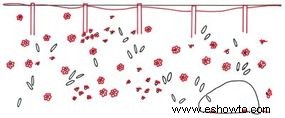
Step 2 :Change the horizon line to one that is slightly wavy. Using a ruler as a guide to level the tops, draw five narrow open rectangles for fence posts. Space them equally. Add a few blades of grass near the boulder with short jagged lines. To form flowers, draw six or seven round petals on about half the tiny circles. Do the same, using fewer petals in a somewhat different shape, for the remainder of the circles.
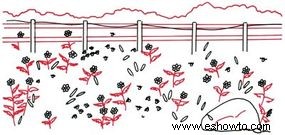
Step 3 :Add stems to some of the flowers with straight or slightly curving lines. Draw leaves, using a curving line on top and a jagged line below. Give shape to the boulder with broken line. Attach rails to the fence posts with the help of a ruler. Remember to keep the upper and lower rails the same width. Above the fenceposts, sketch in a wavy tree line.
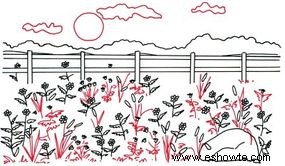
Step 4 :Trace around a coin to form a round sun in the background. Add three irregular shapes with curved but not jagged lines for clouds. Put stems on the remaining flowers with slightly curved lines. Draw long, narrow leaves for the oval-shaped flowers. Use squiggly lines for the remaining leaves. Make shapes like an upside-down V for tall and short tufts of grass.
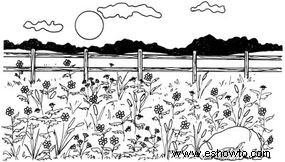
Step 5 :Fill in between the flowers with short, squiggly lines for grass. Draw long lines in the fence posts and rails for texture. Darken the tree line as shown. Shade the boulder with diagonal lines.
Your landscape drawing is finished! Even if you don't get it right the first time, keep practicing until you're happy with your drawing. If you love the majestic beauty of mountains, you will love the mountain vista landscape. Learn how to draw this landscape in the next section.
Want to expand your artistic abilities? See:
- How to Draw
- How to Draw People
- How to Draw Dinosaurs
- How to Draw Flowers and Plants
- How to Draw Faces
- How to Draw Cartoons
- How to Draw Animals
- How to Draw Trains
- How to Draw Boats
- How to Draw Planes
- How to Draw Cars
- How to Draw Buildings
How to Draw a Mountain Vista
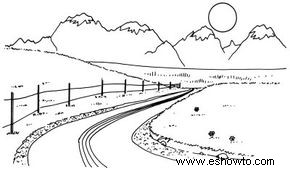 Learn how to draw this mountain vista landscape.
Learn how to draw this mountain vista landscape. A paved road leads to a range of snow-capped mountains, gleaming in the sun, in this landscape. You can almost smell the crisp winter air when gazing at this scene.
In this section, we'll show you how to draw this mountain vista landscape. You can draw it freehand while looking at your computer monitor, or you can print out this page to get a closer look at each step.
Here, we'll show you an illustration of each step and then give you a description of how to draw it. Follow the red lines in each illustration to learn exactly what to draw in that step. The lines drawn in previous steps are shown in gray.

Step 1 :Lightly draw a line across the page for the horizon. Place it about one-third of the way from the top. Add four curving lines, beginning from the lower center of the page and running first to the left and then sharply to the right. Show that the road goes off into the distance by bringing the lines closer together at the top. This use of lines that come together to show depth is known as perspective.
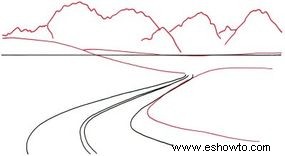
Step 2 :Draw inverted V-shapes using jagged lines to show a distant range of mountains. Alter the horizon line with curved lines to look like gently rolling hills. Create another hill with a lazy curve to the right of the center.
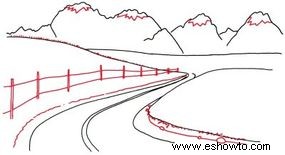
Step 3 :Draw sharply jagged lines for snow caps on the tops of the highest mountains. Add grass on the hillsides and near the road with many slanted and jagged lines. Make a series of narrow fence posts with double vertical lines, making them smaller as they fade off toward the end of the road. Use nearly straight lines to show fence rails. Sketch the edge of the road with squiggly lines. Draw rocks near the road with irregular ovals.
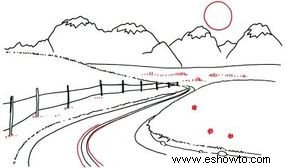
Step 4 :Draw a circular sun in the sky, then put in some tall grass in the middle distance with short lines. Use more short lines for clumps of low grass along the fence. Scatter a few daisylike flowers on the hillside. Add two more curved lines in the center of the road.
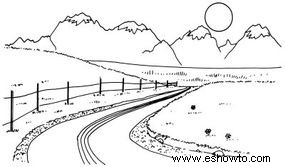
Step 5 :Finish this sketch by adding further details to the shoulder area at the edge of the road. Use plenty of dots and short, squiggly lines to look like rocks and gravel. Place more grass on the hills to the left and right sides using a mixture of short lines, straight and jagged.
Your landscape drawing is finished! Even if you don't get it right the first time, keep practicing until you're happy with your drawing. A lovely winter forest scene can be found in the woodland trail landscape. Learn how to draw this landscape in the next section.
Want to expand your artistic abilities? See:
- How to Draw
- How to Draw People
- How to Draw Dinosaurs
- How to Draw Flowers and Plants
- How to Draw Faces
- How to Draw Cartoons
- How to Draw Animals
- How to Draw Trains
- How to Draw Boats
- How to Draw Planes
- How to Draw Cars
- How to Draw Buildings
How to Draw a Woodland Trail
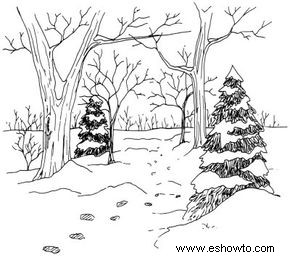 Learn how to draw this woodland trail landscape.
Learn how to draw this woodland trail landscape. This landscape is right out of a holiday story. Pine trees frosted with snow, trees made bare by the winter chill -- even fresh footsteps in the snow.
In this section, we'll show you how to draw this woodland trail landscape. You can draw it freehand while looking at your computer monitor, or you can print out this page to get a closer look at each step.
Here, we'll show you an illustration of each step and then give you a description of how to draw it. Follow the red lines in each illustration to learn exactly what to draw in that step. The lines drawn in previous steps are shown in gray.
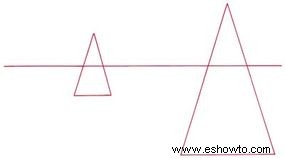
Step 1 :Draw a single line across the middle of the page as the rough horizon. To show the position of the pine trees, construct two tall triangles, a large triangle on the right and a smaller one on the left.
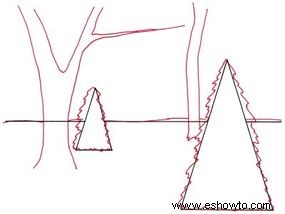
Step 2 :Sketch the outline of a tall tree trunk to the left of the smaller triangle. Wake it wider at the base and narrow it slightly up to the main fork. Then it tapers much more. Put a second trunk on the right side, narrower than the first one. Alter the horizon slightly by adding a few very gentle curves. Use jagged lines to show the profile of the trees.
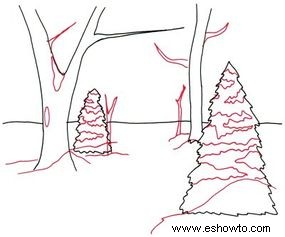
Step 3 :Outline two more trunks for smaller trees in the middle area, between the existing trees. Add some heavy, pointed branches to the larger tree trunks. Form layers of snow on the pine trees by drawing angular shapes with squiggly lines. On the main fork of the larger tree, draw a patch of snow with a rounded triangle. Then sketch a long, narrow oval on the trunk of the tree. Add curved lines under and beside the trees to look like snow drifts.
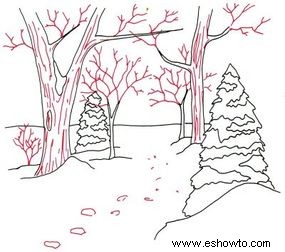
Step 4 :Extend existing large branches with smaller ones made with single, jagged lines. Off to the left side, draw a bush with angular lines. Add a barklike texture to the trees with a series of long, mostly straight lines. Make footsteps in the snow with a string of very rough oblong shapes that look smaller as they disappear into the distance.
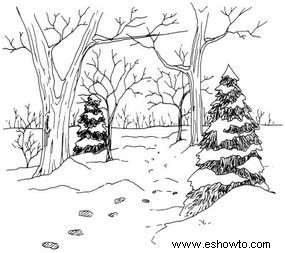
Step 5 :Draw a number of bare trees on the horizon with sketchy, angular lines. Lightly shade in the footsteps with diagonal lines. Add many scribblelike lines on the sides of the pine trees. These lines should be nearly vertical in the middle area of the pine trees but point toward the outer ends of the branches at the sides. Finally, add a few light, angular lines to show drifts of snow.
Your landscape drawing is finished! Even if you don't get it right the first time, keep practicing until you're happy with your drawing. A cool stream is surrounded by lush trees and smooth stones. Learn how to draw the mountain stream landscape in the next section.
Want to expand your artistic abilities? See:
- How to Draw
- How to Draw People
- How to Draw Dinosaurs
- How to Draw Flowers and Plants
- How to Draw Faces
- How to Draw Cartoons
- How to Draw Animals
- How to Draw Trains
- How to Draw Boats
- How to Draw Planes
- How to Draw Cars
- How to Draw Buildings
How to Draw a Mountain Stream
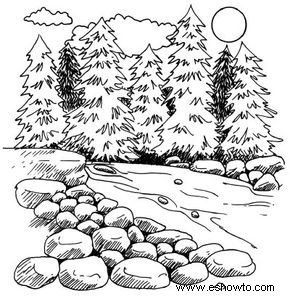 Learn how to draw this mountain stream landscape.
Learn how to draw this mountain stream landscape. This stream sits high atop a mountain, surrounded by lush trees, boulders, and sunshine. This landscape drawing is a great opportunity to practice attention to detail and perspective.
In this section, we'll show you how to draw this mountain stream landscape. You can draw it freehand while looking at your computer monitor, or you can print out this page to get a closer look at each step.
Here, we'll show you an illustration of each step and then give you a description of how to draw it. Follow the red lines in each illustration to learn exactly what to draw in that step. The lines drawn in previous steps are shown in gray.
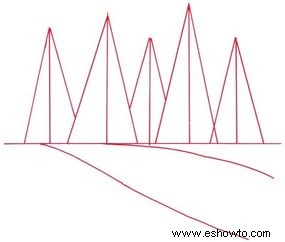
Step 1 :About halfway down the page draw a horizontal line. Sketch the edges of the stream bed with curving lines extending upward from right to left. For pine trees, sketch in a series of tall triangles that overlap one another. Lightly add a line from the top of each triangle down to the base horizontal line.
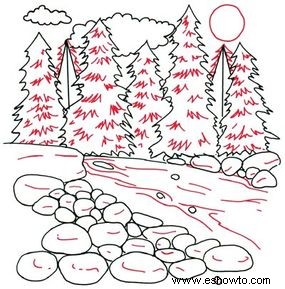
Step 2 :Carefully shape the outline of the pine trees with jagged lines of different lengths. Maintain the sense of depth by showing some trees standing in front of others. Place a large, bumpy, oblong shape to form a boulder along the side of the stream.
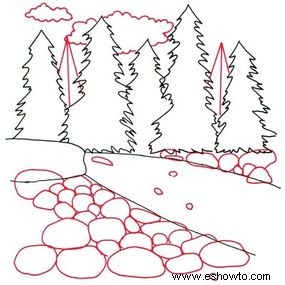
Step 3 :Add more pine trees behind the ones you have already drawn by making triangles as before. Draw scalloped shapes for puffy clouds above the trees. Show rocks on both sides of the stream with irregular ovals. Put more rock shapes on the surface of the stream itself.

Step 4 :Draw a circle for the sun. Shape the two trees in the rear with jagged lines. Add details to the pine trees with short jagged lines. Show the contour of the boulders with slightly curving lines. Put in more curving lines to show the surface of the water.
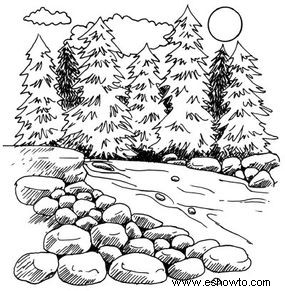
Step 5 :Darken the trees in the rear with many jagged lines. Shade the area under the trees with crisscross lines. Add shape to the boulders by shading with diagonal lines.
Your landscape drawing is finished! Even if you don't get it right the first time, keep practicing until you're happy with your drawing. The next landscape features a beautiful waterfall surrounded by stone and foliage. Keep reading to learn how to draw this landscape in only four steps.
Want to expand your artistic abilities? See:
- How to Draw
- How to Draw People
- How to Draw Dinosaurs
- How to Draw Flowers and Plants
- How to Draw Faces
- How to Draw Cartoons
- How to Draw Animals
- How to Draw Trains
- How to Draw Boats
- How to Draw Planes
- How to Draw Cars
- How to Draw Buildings
How to Draw a Waterfall
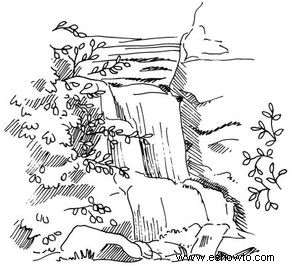 Learn how to draw this waterfall landscape.
Learn how to draw this waterfall landscape. The centerpiece of this landscape is a majestic, rushing waterfall. Surrounded by stone and plants, this waterfall landscape promises a wonderful escape.
In this section, we'll show you how to draw this waterfall landscape. You can draw it freehand while looking at your computer monitor, or you can print out this page to get a closer look at each step.
Here, we'll show you an illustration of each step and then give you a description of how to draw it. Follow the red lines in each illustration to learn exactly what to draw in that step. The lines drawn in previous steps are shown in gray.
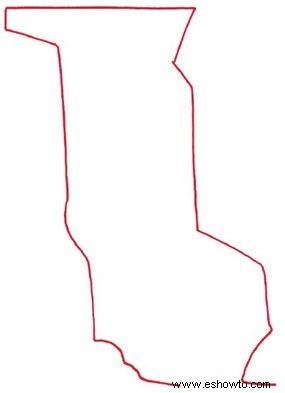
Step 1 :Begin with a rough outline of the watery part of the scene. Form it like a long rectangle with an open, twisted bottom and a boxy, foot-like shape at the top. Use a few curving lines, but most of them should be straight.
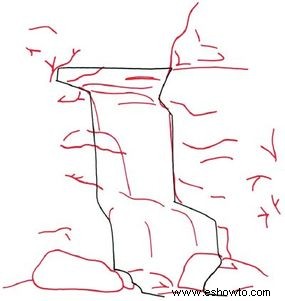
Step 2 :Sketch two enormous boulders at the base of the waterfall with bumpy, oblong shapes. Suggest the movement of water over the falls with gently downward-curving lines. Use curving horizontal lines to indicate the contours of the cliff surrounding the falls. Make tree branches with short, Y-shaped lines.
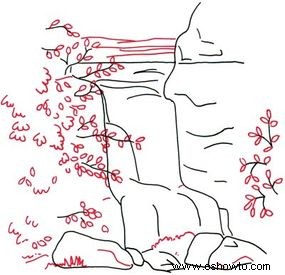
Step 3 :Add teardrop shapes along the branches for leaves on both sides of the water. Use short, scalloped lines to show clumps of leaves. Make jagged lines to look like grass near the bottom. Create the impression of turbulent water at the base of the falls with some squiggly lines. Provide background and a sense of distance with more horizontal lines at the top.
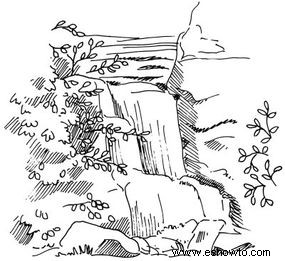
Step 4 :Sketch a series of long vertical lines in the water area to add to the appearance of falling water. Add depth by shading with patterns of diagonal lines alongside the water. Complete the landscape with additional shading in the upper water area, around the leaves, and on the boulders at the bottom.
Your landscape drawing is finished! Even if you don't get it right the first time, keep practicing until you're happy with your drawing. Every city has its own spectacular views. Learn how to draw the cityscape in the next section.
Want to expand your artistic abilities? See:
- How to Draw
- How to Draw People
- How to Draw Dinosaurs
- How to Draw Flowers and Plants
- How to Draw Faces
- How to Draw Cartoons
- How to Draw Animals
- How to Draw Trains
- How to Draw Boats
- How to Draw Planes
- How to Draw Cars
- How to Draw Buildings
How to Draw a Cityscape
 Learn how to draw this cityscape.
Learn how to draw this cityscape. The city has its own brand of amazing landscapes, like this dazzling, towering skyline. This landscape is a great drawing project for city and country lovers alike.
In this section, we'll show you how to draw this cityscape. You can draw it freehand while looking at your computer monitor, or you can print out this page to get a closer look at each step.
Here, we'll show you an illustration of each step and then give you a description of how to draw it. Follow the red lines in each illustration to learn exactly what to draw in that step. The lines drawn in previous steps are shown in gray.

Step 1 :Sketch four horizontal lines below the center of the drawing area. Using a ruler, add a number of rectangles of different sizes, as shown, some overlapping others. These shapes are the front surfaces of the buildings. All vertical lines should be parallel.
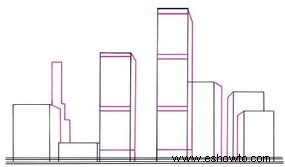
Step 2 :Add a second side to each building to convey a sense of depth. Do this by drawing a vertical line shorter than the two lines for the front of the building.
Connect the side line to the front with a diagonal line. Then lay down evenly spaced horizontal lines on the front surfaces of the two buildings near the middle of the scene. Place another building in the left part of the background with a tall, narrow shape that has steps on one side.

Step 3 :Sketch five trees in front of the middle buildings using squiggly half circles around the top railing. Evenly space pairs of vertical lines on the sides of some of the buildings, as shown.
Use diagonal lines on the sides of the two tall middle buildings to continue the bands. Draw a few more buildings in the background. Give the tall narrow building on the left a second side using parallel lines connected to the front with diagonal lines. Complete the roof using two triangles.

Step 4 :Draw intersecting horizontal and vertical lines on the sides of the buildings for windows. Sketch columns on the corners of the tall building at left using vertical lines with an inverted V shape on top.
Use half circles for arches on the roof of the building at the far right. With more half circles, make the tops of the upper windows. Use dark squares for the windows of the smaller building in the middle, and form the outlines of more buildings in the distance. Draw vertical lines around the base of the tallest building.

Step 5 :Thicken the lines at the bottom of the tallest building and give them rounded tops. Put vertical lines between the bands of the tallest building. Darken the buildings at the back.
Place horizontal lines on the tall buildings at the right and left of the tallest building. Shade the sides of some buildings using diagonal lines. Add short, curved lines to the trees. Sketch curving lines in the foreground to make it look like a watery surface.
That's quite a city! A variety of boats are docked seaside in a harbor scene. Learn how to draw this landscape in the next section.
Want to expand your artistic abilities? See:
- How to Draw
- How to Draw People
- How to Draw Dinosaurs
- How to Draw Flowers and Plants
- How to Draw Faces
- How to Draw Cartoons
- How to Draw Animals
- How to Draw Trains
- How to Draw Boats
- How to Draw Planes
- How to Draw Cars
- How to Draw Buildings
How to Draw a Harbor Scene
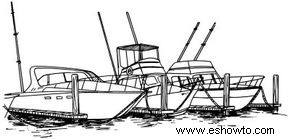 Learn how to draw this harbor scene landscape.
Learn how to draw this harbor scene landscape. If you love marine life, you’ll love this landscape. Learn to draw this landscape scene and you’ll also learn how to draw three very different looking boats.
In this section, we'll show you how to draw this harbor scene landscape. You can draw it freehand while looking at your computer monitor, or you can print out this page to get a closer look at each step.
Here, we'll show you an illustration of each step and then give you a description of how to draw it. Follow the red lines in each illustration to learn exactly what to draw in that step. The lines drawn in previous steps are shown in gray.

Step 1 :Begin this scene in the upper center of the drawing area. For the boats, draw three long, narrow shapes with a pointed end, or bow, on the right side. Make them with nearly straight lines for the tops and curved lines for the bottoms.
Draw the pointed end of the fourth boat on the left. To place the piers between boats, first draw small but long rectangles near the hulls as shown. These will be the ends of the piers. Draw three straight lines back to the left that come together slightly (it may help to practice drawing these pier shapes on a separate piece of paper).

Step 2 :Put in the vertical posts at the ends of the piers with straight lines. Make the post tops and bottoms slightly rounded. Create the top surfaces of the boats, or decks, with long curves running from the tip of the bow. Draw the two cabins on the right with more straight lines. Carefully sketch curved lines on the boat on the left.

Step 3 :Form the guard rails on the front of the decks with two intersecting curved lines. Draw the vertical rail supports with a series of angled straight lines that are parallel to one another and evenly spaced. Add details to the cabins with straight and slightly curved lines. Place a boxlike shape above the cabin of the boat in the center. Use a wide, upside down, U-shaped line for the upper part of the boat on the left.
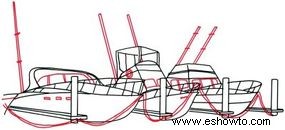
Step 4 :Attach four heavy ropes to the bows of the boats with pairs of curved lines. Draw one or two tall poles or radio antennas on each boat. Use thin lines made with a ruler. Add detail to three antennas with short horizontal lines. Make windows and portholes on the cabins with slanted rectangles. Draw a round life preserver on the side of one of the boat cabins using a circle within a circle.
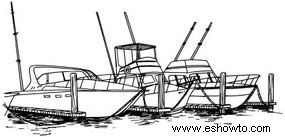
Step 5 :Carefully shade around the bottoms of the boats with a back-and-forth movement of your pencil. Outline individual planks on the piers by adding short, straight lines, spaced closely together on the sides. Put straight and curved lines on the posts for texture. Shade the underside of the cabin's roof with diagonal lines. Add texture to the ropes with short, diagonal lines.
Your landscape drawing is finished! Even if you don't get it right the first time, keep practicing until you're happy with your drawing.
On land or in the sea, in the woods or in the city, beautiful landscape scenes are everywhere. Get inspired and put pencil to paper -- drawing landscapes is one of the best ways to appreciate the world around us.
Want to expand your artistic abilities? See:
- How to Draw
- How to Draw People
- How to Draw Dinosaurs
- How to Draw Flowers and Plants
- How to Draw Faces
- How to Draw Cartoons
- How to Draw Animals
- How to Draw Trains
- How to Draw Boats
- How to Draw Planes
- How to Draw Cars
- How to Draw Buildings

